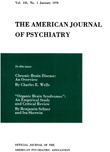A LONGITUDINAL STUDY OF SCHIZOPHRENIA
Abstract
We were not able to demonstrate significant trends or relationships between the onset and course of the disease on the one hand, and the present status on the other, in a group of schizophrenics, many of whom might be classified as chronics. Age at breakdown, acute onset of symptoms, developmental factors, in themselves or in toto, do not appear to be reliable predictors as to the long-term picture of adjustment for such a group. Intellectual endowment and education, which are themselves highly correlated, were found to be predictive indices as to adjustment potential. The most important factor, however, was that of family support–support that took the form of continued responsible acceptance of the patient. As a matter of fact, whether a patient was hospitalized or remained in the community often depended on the extent of direct social support. We suggest that prognosis in schizophrenia depends as much on the unfaltering support of the relatives as on symptomatology or extent of treatment. If direct social support by the family is the necessary determinant for a more adequate and stable level of adjustment, and indeed it appears to be, indirect support–economic, treatment, interest–by D. V. A. is a secondary, but important factor for continuing remission. Long-term involvement with D. V. A. also qualifies relatives' attitudes towards the patient and his illness in a positive manner, thus reinforcing relatives' support of patients. At least in the group we are investigating, it is not surprising to find that the disease has been lengthy and self-limiting, and that patients have been left with some degree of residual impairment. We must emphasize, however, that chronicity diminishes, but does not destroy the patient's capacity to enter into meaningful human relationships. We must further emphasize that treatment responsibility should extend beyond the period when the patient is floridly psychotic. Many patients in fact require lifelong "rehabilitation," and if influences from outside of hospital have as much, and at times more, to do with rehabilitation than treatment within the hospital, then family and community should share in this rehabilitation programme from the very onset of the disease. There is also firm reason to indicate that many a chronic schizophrenic patient is able to learn, by progressive maturation, to be self-supporting, at least partially, in the community, when given the opportunity for a continuing rehabilitation programme.
Access content
To read the fulltext, please use one of the options below to sign in or purchase access.- Personal login
- Institutional Login
- Sign in via OpenAthens
- Register for access
-
Please login/register if you wish to pair your device and check access availability.
Not a subscriber?
PsychiatryOnline subscription options offer access to the DSM-5 library, books, journals, CME, and patient resources. This all-in-one virtual library provides psychiatrists and mental health professionals with key resources for diagnosis, treatment, research, and professional development.
Need more help? PsychiatryOnline Customer Service may be reached by emailing [email protected] or by calling 800-368-5777 (in the U.S.) or 703-907-7322 (outside the U.S.).



